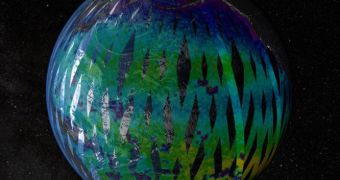When the SAC-D satellite will launch into Earth's orbit later this year, experts will finally have the necessary capabilities at their disposal to establish the link between salinity and the planet's climate patterns, ocean circulation and water cycle.
Such a discovery would clear up many mysteries related to how Earth's systems are functioning in concert, the experts say, and would allow for a deeper understanding of how the aforementioned systems influence each other.
In turn, this would lead to the creation of more advanced computer models, that will help climate scientists simulate with a higher degree of precision the effects of global warming.
All of this will be made possible by the Aquarius instrument on the Satelite de Aplicaciones Cientificas-D (SAC-D) satellite, which is being developed by NASA and the Comisión Nacional de Actividades Espaciales (CONAE), the Argentinian space agency.
The Aquarius instrument will play a critical role in the detection of salt, as well as in measuring salinity around the globe. The satellite's orbit will enable experts to get constant readings from all over the place, and monitor how the data changes over time.
In the end, the new work will enable us to figure out how the ocean and the atmosphere interact, and what role salinity plays in all of this. The glimpses that scientists got thus far indicate that salt concentrations in the North Atlantic are one of the main reasons Europe is habitable.
“About 80 percent of Earth’s water cycle takes place over the ocean. By measuring ocean surface salinity, Aquarius will be able to track how the water cycle is changing in response to climate change,” explains Gary Lagerloef, quoted by Space Fellowship.
The expert, who holds an appointment as the principal investigator of the Aquarius mission, holds an appointment at the Seattle-based Earth & Space Research. He explains that the satellite will also measure evaporation rates, as these too can contribute to changing the atmosphere.
A salinity-measuring mission has been a long time coming, and the SAC-D spacecraft is exactly what the international scientific community needs at this point. It was created following a genuine international effort, and it has just finished a series of tests meant to validate it for flight.
““Today’s salinity maps don’t show many features in the Southern Ocean. This is because data there are so sparse. Yet the Southern Ocean is one of the key deepwater formation areas in the world and is one of the key drivers of deep ocean circulation and heat transport,” says expert Yi Chao.
The expert holds an appointment as an Aquarius project scientist at the NASA Jet Propulsion Laboratory (JPL), in Pasadena, California. The JPL jointly built Aquarius with the NASA Goddard Space Flight Center (GSFC), in Greenbelt, Maryland.

 14 DAY TRIAL //
14 DAY TRIAL //